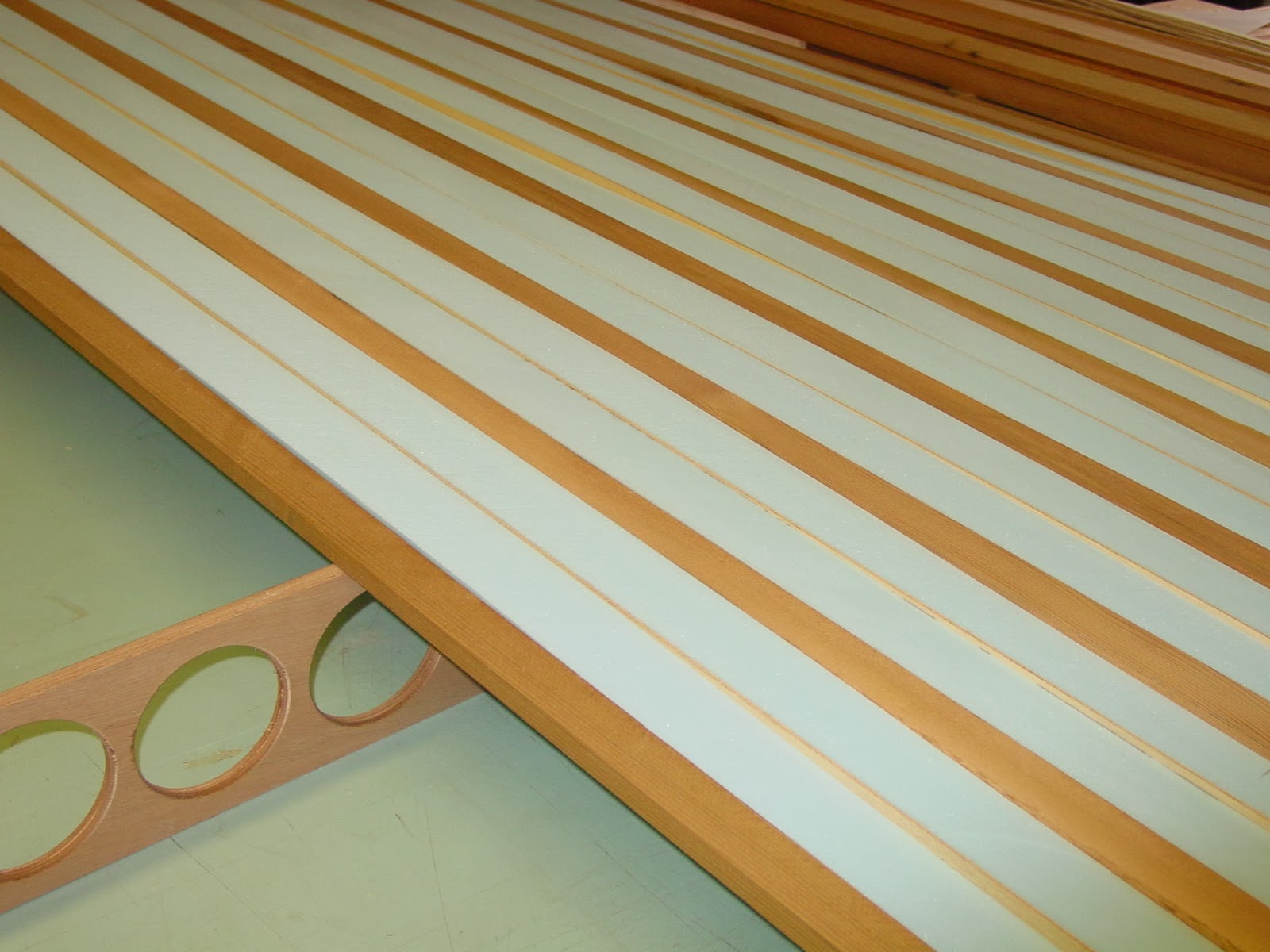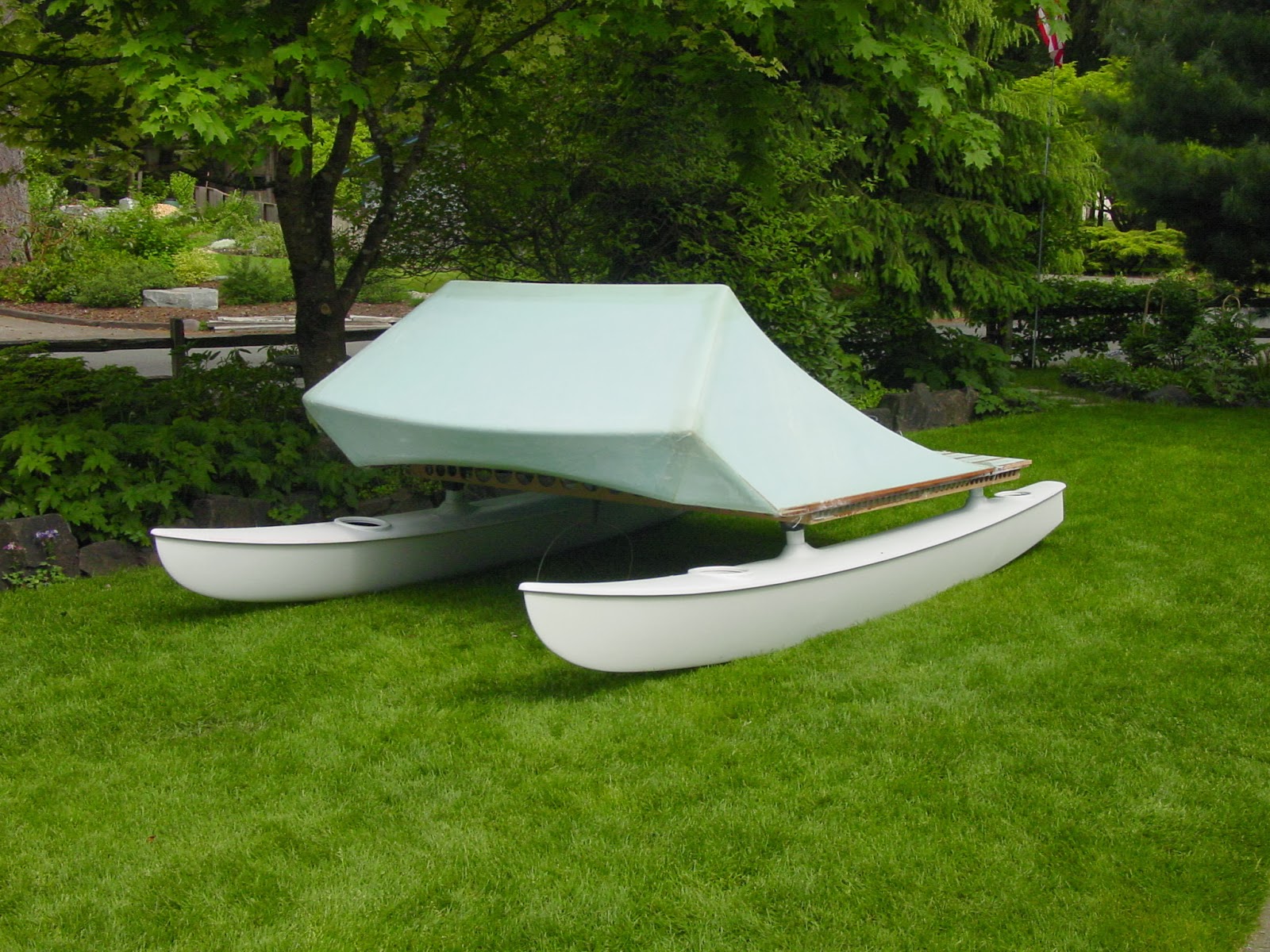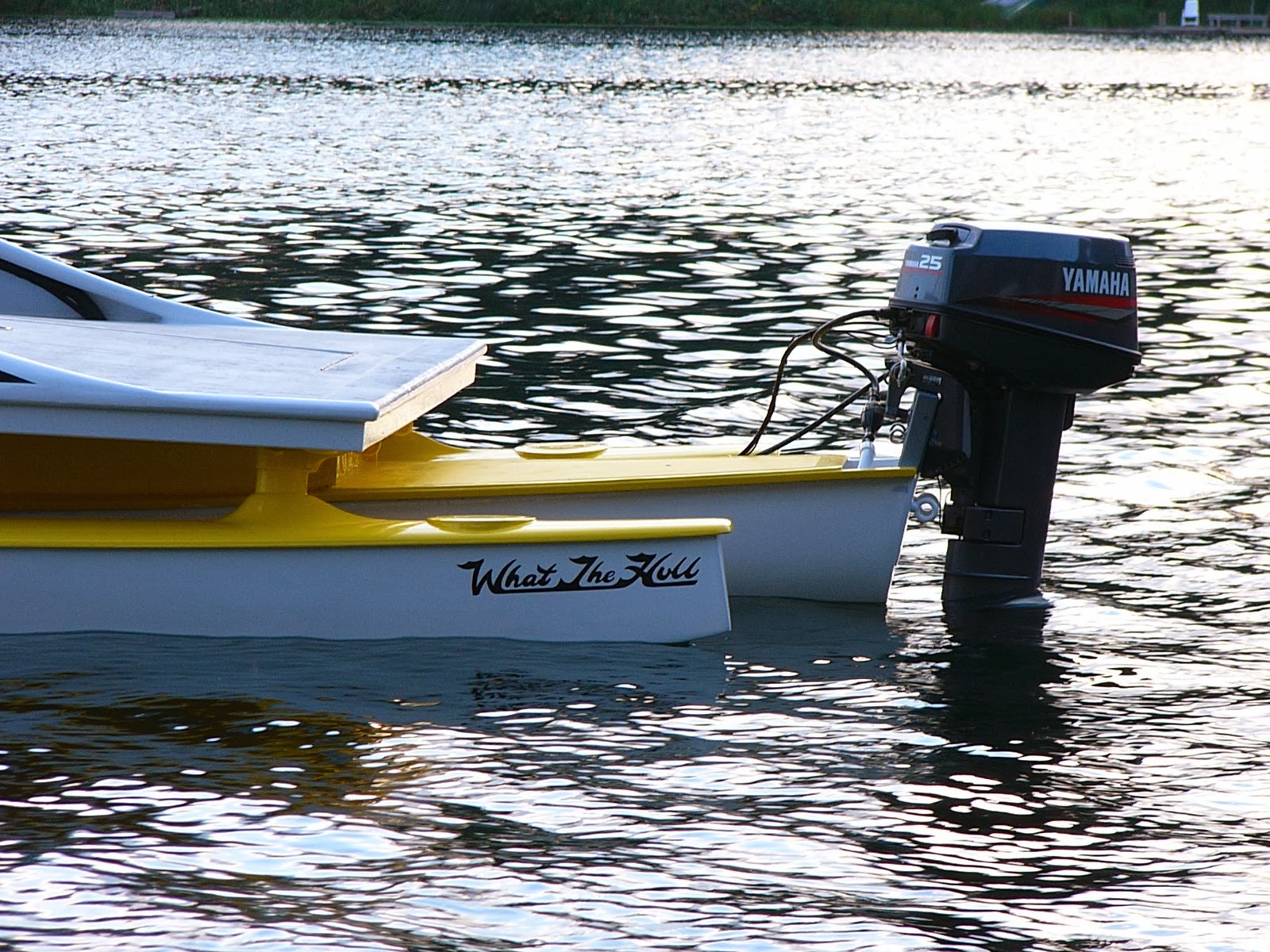What The Hull
Another guy GAVE me his 1990 15 hp Johnson two stroke...
With no specific plan and uncertain expectations, my catamaran conversion
was underway... I dismantled the catamaran, removed anything required to sail
it and set about cleaning the hulls...That involved wet sanding and removing
silicone caulking in places it didn't need to be...
The
trampoline replacement was next... My plan was to do a deck composite of
1/2" x 1.25" cedar and 1/2" foam...run lengthwise and epoxy /
glass over and under...The deck would have the natural arch that Hobie's have at
the front crossbar... A design
element that wasn't my preference, but something that would require a lot of
effort and money to change...
(Above)
The tramp replacement sub-frame...It's mostly a high grade 1/2" marine
ply...Drilled out to reduce weight, yet still retain strength...12#
(Above)
Here's what used as the deck...It's mostly 1/2' blue Styrofoam, with 1/8"
lauan plywood "stringers" between, with 1/2" cedar thrown in... The 8' x 8' unglassed deck weighs 20 #...
(Above)
The deck is laminated with 9 oz. Volan and epoxy resin...Next step was to trim
the edges and cut a rounded nose...
(Above)
This is the underside of the tramp replacement...The framework is 1/2"
high grade marine plywood with some cedar web braces...You can see the chalk
line that marks the rounded nose...I used my 5'10" fish template for the
curve... The framework is bonded
to the deck with high strength construction adhesive...I coved it and glassed
on a layer strip of 9 oz. volan / epoxy...
I wanted the tramp replacement to offer some wind and spray protection..
(Above)
So I built a "cabin" in front with Styrofoam... Styrofoam is so
easy to work with, and cheap too...It cuts easily with a knife, shapes with
sandpaper...To hold the seams together I used Liquid Nails Heavy Duty
Construction Adhesive...It sets up pretty fast, and after a day it can be
sanded...Once the pieces are set, it's ready to be fiberglassed...Styrofoam
must be glassed with epoxy resin, at least to laminate...Polyester resin will
melt the foam...Your sanding coats can be polyester...It takes epoxy a week or
so to fully harden, but I'm using less glass than I thought I
would...Structurally, I'm surprised how rigid it is, considering it's light
weight...
After
I took those picture I decided to cut a curve in the top side rail...I used my
8' egg template for the curve...Making the curves and lines come together
was harder than I thought...
(Above)
The front is now together...The joints have been rounded and it's
laminated...The interior sides have been built out and rounded (like a
surfboard rail)...The front arch is attached and ready to be sanded, then
glassed...
Back on the boat design ...
From
what I've heard, the catamaran set-up needs refinement for it to achieve it's
full potential...The recurring "problem" seems to be the motor just
hanging in the rear...My solution was in my back yard...For years I've had a
15'9" fiberglass square end canoe...If I could figure a way to have that
be the motor mount, and if I could figure a way for it to connect to the
catamaran, I might be on the road to a better boat...
So,
I'm going to make it a Tri-maran...The canoe will solve some issues as well as
present a few smaller challenges...It looks very promising overall...I put the
catamaran together in the backyard and placed the canoe roughly where it might
end up...
(Above)
The canoe is between the cat hulls...I like how the lines all work together...I
think it'll get up and plane pretty easy...One benefit of adding the canoe is
capacity... The catamarans weight capacity is 500#...The canoe's capacity is
1,085 #...
(Above)
The fiberglass top 'THING' started off as a necessarily of design, based upon
Vic's pictures... When I started, the
canoe wasn't part of the equation... Since the canoe has been
incorporated, I now have even more flexibility in potential usage...Fully
covered, it'll withstand any rainstorm...Oh, the possibilities...
(Above)
I'm made fixed bulkheads out of 1/2" marine plywood to connect the cat's
crossbars to the canoe...I'm going to have some aluminum brackets made that'll
be welded to the crossbars and be able to bolt to the plywood risers coming out
of the canoe...At the ends are deck covers for the canoe, to keep water
from entering the "hold"...On the bow is a "hatch to allow
access to the front...It's a Heavy Duty Garbage Can, that's been cut...I sawed
the top 3" from the barrel, and epoxied / fiberglassed it in place...The
lid snaps tight...This creative stuff is fun...!!!...

(Above)
The cat hulls are fully painted, the canoe hull / deck is 95% done...The
crossbars are finally ready to be picked up from the welding shop ...I still
have the motor / tank mounting to do, but it's getting a lot closed to water
testing...
I'll
run it for a while without the "deck" on...That will take at least a
couple of weeks for me to finish glassing and painting...Whew, it's a lot of
work...
The
crossbars and mounting brackets will be painted yellow.....Interlux Brightside
Polyurethane...A hard, high gloss, single-part polyurethane...Available at any
boat store... Applied with a thin foam
roller, then "tipped off" with a good paintbrush...
(Above)
Check out the 1/4" thick aluminum crossbar brackets w/ gussets...
(Above)
The deck lines seem like they were made for each other... Balanced... I'm
really stoked how it's all come together...
The much-anticipated launch...
(Above)
Mid-afternoon I hooked the trailer to the van and headed to Pattison Lake...At
the boat launch it was completely empty...There was a 15 kt. wind out of the
west...I unhooked the lights, loosened the straps and put the trailer in over
the tires...The hull slipped off real easy...I pushed the boat into the weeds
and parked the trailer...The motor started easy, I pushed off, jumped on and
soon I was just cruising along at a nice, faster than walking speed...Very
smooth...I hooked up the tiller extension, and was pleasantly surprised how
easy it worked...Good speed control and accurate steering...
(Above)
I'll use a tiller extension on the outboard... The extension of course is modified...It's a u-joint set-up built for
outboards...But the stock stick was too short for my purposes...So, I got a
heavy duty painter's extension pole that has a treaded end that goes into a
paint roller... I cut off the u-joint thing and epoxied the threaded end thing
into that...The painter's pole has a well thought out one push of a button
quick disconnect...It's a hex fitting so it won't spin...Very easy to set up
and use...I'll be fine with it until I set up a real throttle / steering wheel
set-up this winter...
(Above)
The underside of the deck... You can see the access hatch cutout and framing...
The opening is 22" x 26"... Using the time honored method of
computing capacity, using an abacus and verifying it with a slide
rule, my calculation confirm with mathematical certainty that there will be
29.5387 cubic feet of storage capacity under the main deck... The Bow will hold the 14 gallon fuel cell and
be home to the anchor...The stern will hold the life jackets / safety gear,
leaving the center section for folding chairs, towels/wetsuits, food/drink,
etc...
(Above)
I mostly just cruised the lake, but I opened up the throttle a few times, not
top speed yet, but enough to get a sense of what the motor will do...I'll be
fine with it for the foreseeable future...
One
thing that became apparent was, at speed the water coming off the canoe hull is
directed at the catamaran hulls...It rebounds off those and unless I build the
"side walls" higher, I might have water coming into the canoe...I had
planned to do that, even before the test ride, but it's now higher on the
priority list...
The
balance of weight is fine...Super stable, and once I permanently mount a 14
gallon tank in the bow, it should be perfect...
(above)
I built a 4.5" extension for the transom...Multiple layers of marine
plywood, sanded, routered and painted white...Through bolts hold it solid...In
addition, I got a "Sting Ray Hydro Foil Jr." for the cavitation
plate...Finally, I moved the pin that adjusts the motor angle all the way
forward...
(Above)
You can see the relationship of the bottom to the prop....In use it works
superb...I think that raising the motor made the biggest
difference...The bow stayed down and the stern rose perfectly, even at the
slowest speeds...I think I was getting much lift out of the tail though
because of the way it flairs up and has a keel built into it. The water exits
smoothly but that shape doesn't do anything for the planning characteristics of
the craft. I think the "Hydro Foil" on the motor overcomes the
natural tendency for the tail to sink...At speed, the water exits the rear co
cleanly...
I
went from stoked to"YEAH BABY"when I first gave the
throttle a real twist...This excursion had me holding onto my hat...I'm
estimating that I was cruising at about 15- 20 mph...Problem solved...
(Above)
Here's the 14 gallon fuel cell installed in the bow...I'm using about a quarter
gallon an hour cruising the lake ...Can you say " All day
cruising"...???...I knew you could...
(Above)
Looking into the "hold" towards the bow...I enlarged the opening to
the bow and stern, now that the deck is fully enclosed and watertight at the
gunwale level...You can see the fuel cell up there...
(Above)
Looking into the stern...That's my folding chair sticking out...
Oh, by
the way, the name of the boat is:
...???...What The Hull
This
project was full of all the stuff I love...Facing design issues and coming up
with solutions that are beyond common...


































































<< Home